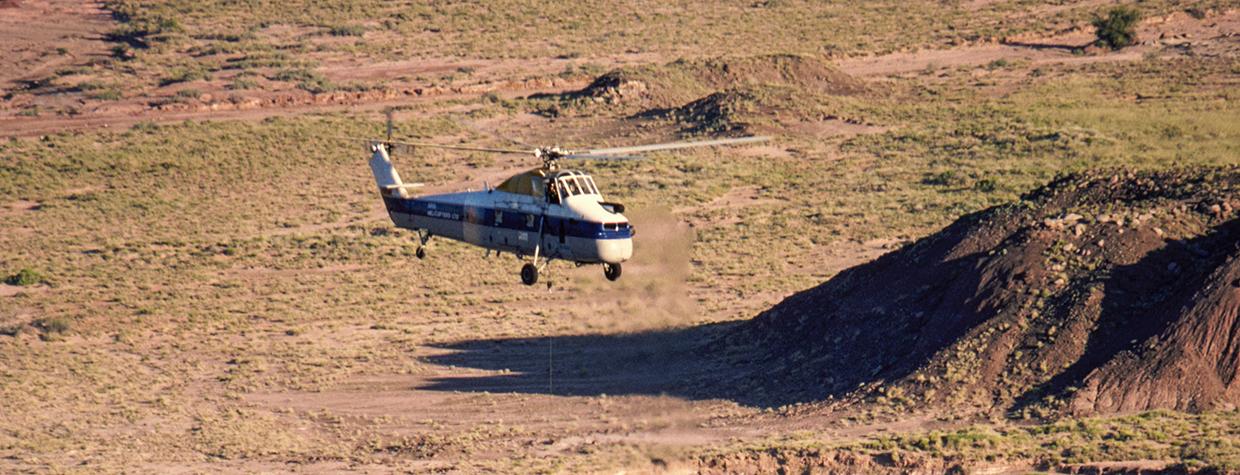On a cold, clear December morning, Adam Marsh takes in the panorama from Petrified Forest National Park’s Hózhó Point. Nearby, the Painted Desert Inn glows in the early light, its windows reflecting the ruddy mounds of the landscape for which it’s named. “I love being out here,” Marsh says. “It’s just so quiet.
“That’s our northwestern corner,” he continues, pointing. “Everything north of that is the Navajo Nation, and those are the Hopi buttes. You can actually see the San Francisco Peaks, which is, what, 140 miles?”
Tall and lean, with boyish good looks, the park’s lead paleontologist began his work here with an internship more than a decade ago. And as part of his doctoral dissertation, he studied one of the park’s most famous discoveries: the early Triassic dinosaur nicknamed “Gertie.”
“Part of our wilderness management plan is doing active science,” Marsh says. “Yale used to work way out there in the corner, in the badlands. They were out here for about 10 years. We have researchers from the Smithsonian [Institution] who go out to that section on the other side of Pilot Rock, way out there.”
Marsh points to three ash-colored mounds of descending size in the foreground. “See the upside-down ‘snowman’?” he asks. “The little valley on the other side of the middle ‘snowball’ is where Gertie’s from. That blue streak there is the layer from which Gertie was found.”
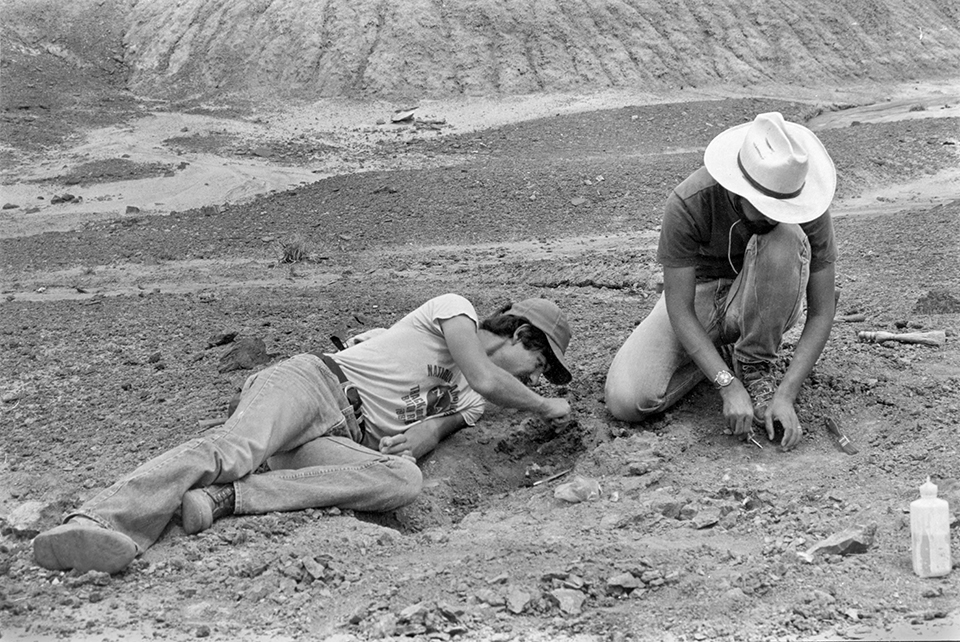
It’s hard to imagine what this peaceful place must have looked like 40 years ago, when it was called Chinde Point. On June 6, 1985, a helicopter’s rotors cut the quiet and the ground teemed with journalists from around the world. They’d come to see Gertie, a newly discovered dinosaur species believed at the time to be the oldest in the world, get airlifted out of the park.
It was arguably the biggest event in the park’s history, and residents of nearby Holbrook were giddy, plastering the windows of nearly every business in town with hand-drawn pictures of dinosaurs. “I’m not sure anything this big has ever happened to Holbrook,” a local woman told a Los Angeles Times reporter. “The only thing that comes close was the time [actor] Henry Winkler rode through town in a limo.”
So much about Gertie’s discovery came down to luck. If it hadn’t rained and Rob Long hadn’t been annoyed, the dinosaur might not have been found.
“Rains pushed us from [south] PFNP to north,” the self-taught paleontologist who led the field crew wrote in his notes. Long worked as a research associate at the University of California Museum of Paleontology in Berkeley and had followed his mentor to Petrified Forest, as had a succession of prominent paleontologists from the museum before him.
On that late-August day in 1984, Long was searching for fossils with three other crew members when one of them began to “erode” his nerves. He sent the annoying crew member in one direction with Bryan Small, a graduate student at Texas Tech University, while Long explored in the opposite direction with the other.
Small soon spotted a few scattered bones and investigated. As luck would have it, one was an ankle bone, key to distinguishing a dinosaur from other Triassic-era vertebrates. “Even though I’d never found one before, I thought, Oh, this is a dinosaur,” Small recalls. “So, we immediately found Rob, and the rest was history.”
“We know beyond any doubt he’s a brand-new dinosaur,” Long told reporters at a press conference. And he believed it was the oldest dinosaur ever discovered. “It was pure luck that Bryan Small found this specimen,” he said in the documentary A Whopping Small Dinosaur. “The rate of erosion in the Petrified Forest is remarkable. With the rains coming in each year, bones that aren’t discovered are quickly turned to powder. They literally explode.”
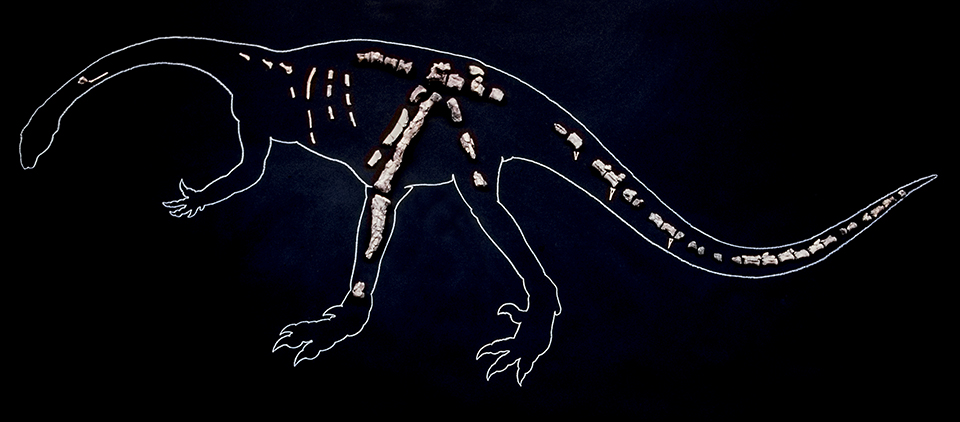
Officially, Long named the specimen Chindesaurus bryansmalli, after the nearby overlook (which became Hózhó Point in 2023) and the dinosaur’s discoverer. The use of Small’s first and last name was unusual: Even though Long estimated the dinosaur to be about the size of a German shepherd, he used Small’s full name so people wouldn’t assume the name referred to the dinosaur’s size.
Long also gave it the nickname “Gertie,” after a cartoon dinosaur in one of the earliest films ever made, and the name stuck. When another paleontologist, Bill Parker, tried to look up the catalog record for Chindesaurus almost 20 years later, he couldn’t find it. It had been filed under “Gertie.”
The field crew returned the following June to pack up the fossils that remained in the ground and transport them to Berkeley for study. It took three days to excavate the block of earth that contained the bones and encase it in protective plaster.
The resulting package weighed about 1,500 pounds, far too heavy to haul out. A helicopter was arranged to lift it, suspended by straps, to the overlook, where it was loaded into the helicopter using a forklift. Hordes of people packed the point to watch. At the end of his otherwise matter-of-fact field notes for the day, Long wrote, “Media coverage was horrendous.”
“It was terrifying,” Small recalls of the press conference. “I had not had to deal with that before … the cameras, the people, people asking questions. And I had to get up and talk. Looking back on it, I guess I’m glad it happened, but at the time, I was thinking, Get me off of this stage!”
By contrast, in the documentary, Long — witty, charming and wearing a ranger uniform — appears to be enjoying himself during the press conference, describing Gertie’s discovery as “a news story that’s taken 225 million years to develop.” It would take three to six months to extract the fossils from the earthen matrix, he told reporters, and about a year for the specimen to be described and returned to the park.
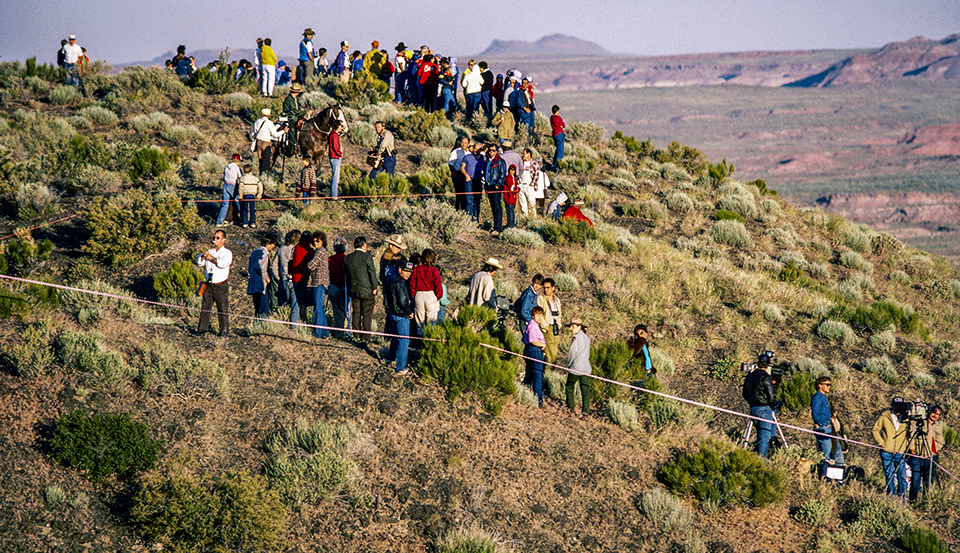
The media attention didn’t end with the press conference. Small remembers being awoken at 7 a.m. by an NPR reporter. “Everybody wanted to do interviews,” he recalls. [It was] a bit overwhelming, to be quite honest.” And Long’s widow, Jerri, says her husband had barely returned home before their phone started ringing off the hook: “Unbeknownst to us, UC Berkeley sent out a press release listing our home telephone number as a contact. People around the world did not recognize the time change. … We literally had to unplug our landline phone to get some sleep.”
At the end of the month, Long wrote: “The ‘Gertie the dinosaur’ media splash has been exhausting, but hopefully it will have served some good purpose for the park. This poor dinosaur has been definitely ‘over-killed.’ ”
Long’s timing estimates turned out to be wildly optimistic. A decade had passed before he and an associate had described Chindesaurus bryansmalli in the scientific literature. And in the early 1990s, when Vincent Santucci was hired as Petrified Forest National Park’s first paleontologist, Gertie was still in California. “One of the things the superintendent wanted me to do was to get that dinosaur specimen back,” recalls Santucci, now senior paleontologist for the National Park Service.
He also had to manage expectations. While indeed a very early dinosaur, Gertie did not prove to be the world’s oldest. And although Long described Gertie as “a whopping small dinosaur” from the start, no one in the community had actually seen the specimen. “When people think of dinosaurs, they think of huge skeletons,” Santucci says. “Well, the remains of this dinosaur … were very, very limited. And it’s a small dinosaur.”
Gertie arrived via UPS in a box the size of a computer keyboard. “I knew the superintendent would be excited, so I ran upstairs and brought this specimen,” Santucci recalls. Outside, a rare summer storm was raging, with high winds and hail. Known for his dry wit, then-Superintendent Gary Cummins said, “I knew it would be a cold day in hell before we got Gertie back.”
Before Long died in 2023, he donated his personal paleontology library to the park, which plans to set it up as a research library. “When I contacted him in the mid-2000s, he had no idea that some of his work was really influential,” says Parker, now the park’s integrated resources program manager. “He was building this gigantic dinosaur scrapbook [with] a folder on every single dinosaur that’s known and every piece of information that he could find … for researchers to use. So, that’s what we acquired.”
An interpretive display about Chindesaurus stands at Hózhó Point, and a cast of its bones is displayed at the Rainbow Forest Museum. Along with the park’s other important specimens, its fossils reside in the site’s museum collection, in a cabinet on casters so it can be evacuated in an emergency. Researchers still come to study them, and the park commemorates the airlift each June 6 with an event called Dinosaur Day.
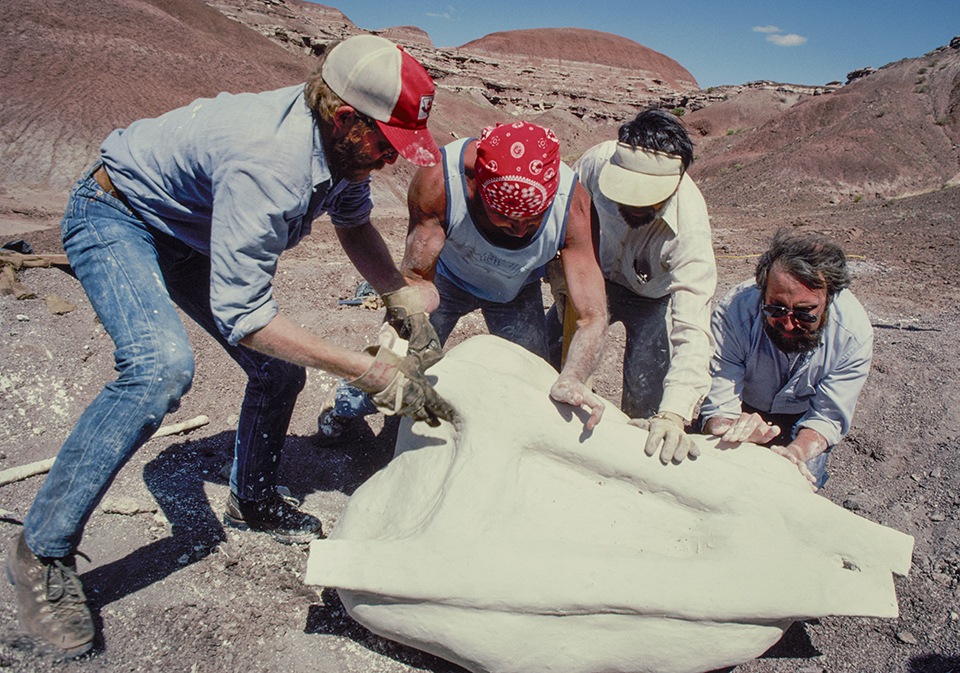
“When it was first discovered, it was probably not the oldest in the world, but definitely considered to be the oldest in North America and maybe even the most primitive,” Parker says. In North America, dinosaurs from the Triassic are rare, and there were only a couple of known species, he adds. But Chindesaurus was the first new dinosaur species discovered in almost 100 years, and it inspired research into Triassic dinosaurs. “At the time, we didn’t know much about dinosaur origins,” Parker says — 20 years ago, for example, a book about dinosaurs would contain information about their extinction but almost nothing about their origin.
“The volume that Robert Long and Phil Murry published [in 1995] where they first described Gertie was significantly influential on all this work,” Parker adds. “It was definitely driving what we were doing back in 2001 and 2002. … The cool thing is that [Long] wasn’t really that far off. His ’95 publication is still pretty spot-on.”
Pieces of Chindesaurus still surface occasionally — in 2019, a high-school student discovered a vertebra belonging to Gertie on a Dinosaur Day hike. “Every time it rains, there’s as much as a centimeter of erosion in some of these badlands,” Marsh says. “So, every time it rains, there’s an opportunity for discovery. Even one thing can be significant. It can be the first of its kind. It could be a new species. It could be the oldest. It could be the first one in North America. So, there’s really an unprecedented opportunity for finding things like the next Gertie. There’s so much that we don’t know, and all we need is the right fossil.”
Gertie not only advanced scientific understanding of early dinosaurs, it also had a lasting impact on Holbrook. “It’s one of the reasons that you drive through Holbrook and see all those concrete dinosaurs,” Marsh says. “It’s because of Gertie. Literally. Those weren’t there before that discovery. So, I think that’s really special.
“I’m excited to celebrate the 40th anniversary this summer. We’ll definitely have a big party for Gertie on June 6 again this year.”
For information about this year’s Dinosaur Day celebration at Petrified Forest National Park, call 928-524-6228 or visit nps.gov/pefo.

